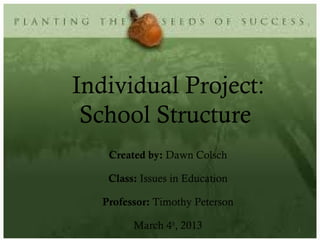
Redefining Public Schooling and the Role of Privatization
- 1. Individual Project: School Structure Created by: Dawn Colsch Class: Issues in Education Professor: Timothy Peterson March 4th, 2013 1
- 2. Introduction Should “public schooling” be redefined? Has the Supreme Court reconfigured American Education? Are local school boards obsolete? Is privatization the hope of the future? Within this presentation, I will attempt to shed some light on all four of these big questions currently troubling many educators and the like.
- 3. “Do we depend on out moded industrial age thinking when working with complex organizations? 3
- 4. It is no secret that today’s education requires much more complex ideas, strategies, and evaluation than generations ago. The children of the future sure are not just raw materials that we can send through a process of assembly and in return get a perfectly fit member of society. They require caring, guidance, acceptance, variety, understanding, and choice. Classrooms today are not homogenous and if so, I believe they should not be. This is not the way of the world and should not be the way of education. When asking the question of how to educate such a complex group of young people, one is reminded of the importance of innovation. A world without innovation stands still as does an educational system. We should never say that things are ‘good enough’. So is the answer privatization? Well, we live in a diverse world. I understand that diverse may be an ‘umbrella term’ as Hess would say, but when I say diverse I mean that we have a great deal of variety. This variety demands accommodations which may come as privatization or publication, school boards or teacher partnerships, conventional or original, teacher or apprenticeship, etc. I believe that there is not just one way to work with complex organizations... hence the complexity. Things that would guarantee advancement in education are teacher training and selection improvement, educational funding, mentoring programs, and continued educational research. “Education should be about lifting up, not weeding out” - Robert Niles
- 5. What do you propose to be the organizational structure and financial base for schooling in the US? 5
- 6. With voucher programs, charter schools, public schools, private schools, religious schools, home-schools, magnet schools, alternative schools... goodness, I could probably go on... it’s hard to tell what the organizational structure and financial base is. Each school has their own structure and even though this idea is extremely convoluted, it’s one of the many reasons I love my country. Our government, currently anyway, does not restrict us to one way of learning. It welcomes all religions, ideas, and choice. I propose that we retain our diverse organization and finances, and look towards improving individual organizations. I support public school policy of “free schooling”, but also see the hardship of underfunding and therefore support the occasional need of ‘for-profit’ programs. I also support local school boards, but believe that teachers should play a larger role and perhaps partner with school boards in order to share their expertise.
- 7. What options should be available? 7
- 8. I believe that Americans hold the right to deciding what type of school their children go to. I am, of course, bias towards public schooling because that is where I hold my current career, but I also support the right of choice. Certain areas of the country have some very difficult situations. One of which being the inner-city populations that Joe Nathan spoke of in the text. No matter what the laws and regulations are, schools seem to find loop holes in the system. It is not exactly fair that some public schools have admission tests or that some public schools are in areas that call for an extraordinary annual income base. Unfortunately, I don’t see a solution to these problems and they need to assessed on an individual basis.
- 9. What requirements should exist concerning PK-high school? 9
- 10. When evaluating a student, one should look at whether the student improved. Ideally, a student should excel one “grade level” each year. Now, how is a “grade level” assessed? This has been proven a difficult question when No Child Left Behind advocates were unsuccessful in answering. I support specialized education at a certain age of maturity. Students should be taught the same material to a certain extent of readiness. When young people approach a point of maturity where they are channeling towards a particular career path, I believe that they should have the option of specializing their class schedule. In this case, they would be honing in on what they feel is important in their lives and they would feel the appreciation of surrounding adults and mentors. This would lead to increased motivation and intrinsic value.
- 11. Conclusion What does Public Schooling really mean? What do I choose Public or Private? What role does the government or should the government play in education? These are all questions that will concern Americans for many years to come. I think the important question for educators is: What can I do today to help my students have a more successful future?
